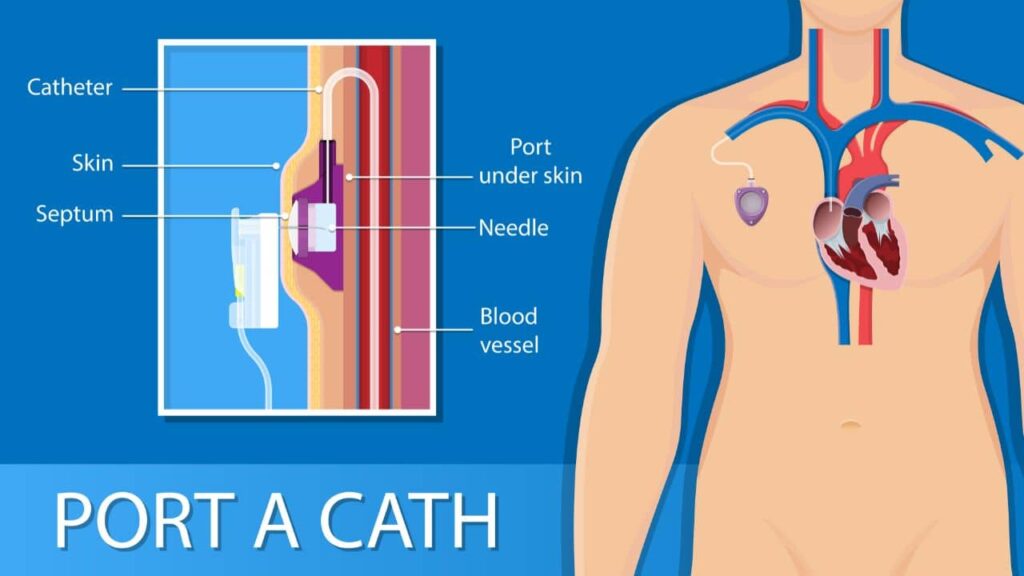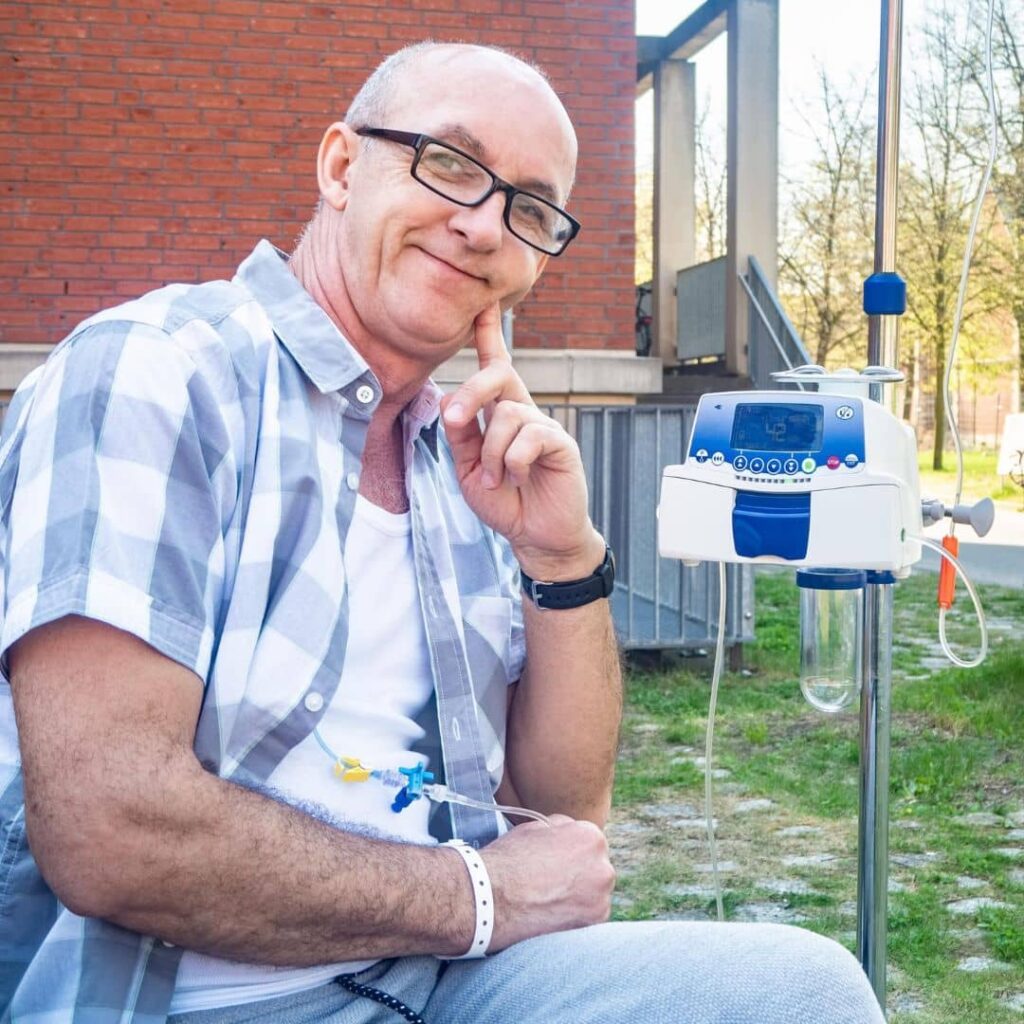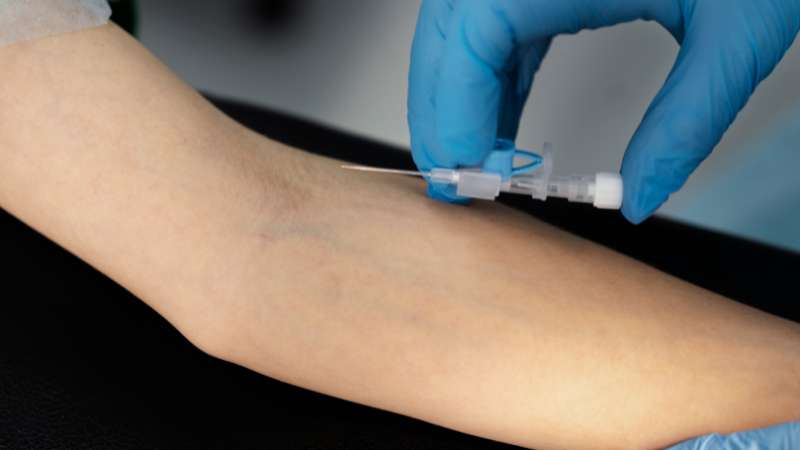A medical port (called a port-a-cath [PAC] or mediport) is a small, permanent tube that lives beneath the skin. It’s generally implanted under local anesthesia and can be used to give a person medication like chemotherapy or get samples of blood. The port lies below the skin and you can go about your day without anyone knowing it’s there.
A port is an option for people who have trouble getting blood draws and need to be monitored closely. It makes it quicker and easier to get the care you need.
A port can also make your treatment plan more efficient. Instead of going through repeated rounds of tests with needles, you can just go in every so often for a quick checkup using the port. Then your doctor knows everything is OK and can keep planning treatments based on those results. This keeps you comfortable, safe, and healthy during cancer treatment.
Table of Contents
ToggleWhat are the Indications for a Port-A-Cath/Mediport?
The indications for a port-a-cath include:
- Recurrent or persistent infections:
- Recurrent or persistent infections: In the past your doctor may have had difficulty placing a catheter for chemotherapy, blood draws or other parenteral therapies. A port can be used instead of a PICC line to give you these treatments.
- The need for repeated or ongoing venipuncture procedures (blood draws):
- The port-a-cath may be used as an alternative to frequently using intravenous lines such as PICC Lines or Hickman catheters.
- Chemotherapy access for people who cannot build enough scar tissue to draw blood from veins in their arms.
- Administration of cancer medications, fluids and nutrition directly into the bloodstream while a patient is receiving chemotherapy or during palliative care (even if not getting chemo or pain management).
- Removal of fluid drainage from lymph nodes for patients undergoing radiation therapy. Wider and more frequent range of arm motion may be allowed by using a port rather than long periods of immobility associated with being tied off each day.
- Anecdotal reports indicate better quality of life as well as improved circulation after lymph node dissections developed adhesions which had made elbow movements painful before treatment via a port was begun.
- Prevention of infection since the over The port allows physicians to easily access a large vein with less risk to infection. An adult portal chamber takes about 2,000 punctures.
This can last several years. By injecting chemotherapy using an intravenously powered vein a lower probability exists the drug would leach into tissues and result in extravasation or irritation. Surgical implants are considered a minor surgical procedure performed through local or general anesthesia by interventional radiologists or surgeons.
Some day after the procedure this may happen the patient has experienced discomfort at implant site and is generally manageable by NSAIDs. Once the procedure has gone formally approved the patient can be taken into intravenous therapy through the ports.
How does It Work?
A mediport or PAC works by acting as a one stop shop for all of your medical needs. It is a small, permanent tube that you can go about your day and no one will notice it.ve cancer and are going to be getting chemotherapy, radiation therapy or other treatments that require medications (like blood transfusions) the port is a simple way to keep your veins clear. It’s not always used on every day of a treatment.
Using the port can save time for patients who need repeated blood draws or injections in their veins.
Getting a port allows you to move around without worrying about other devices straining your venous system. The port reservoir measures is less than the size of a quarter, Your port is placed under your skin with a needle while you are awake. You can go about your day without anyone knowing it’s there. It reconnects to the same major veins that draw from when you have blood drawn or get an IV put in.

Can It Be Used for Anything Else?
Yes! Sometimes a person will need blood withdrawn, such as when they are being evaluated for a lifesaving bone marrow transplant or in treatment before having heart bypass surgery. The port can be used during the transplant surgery to withdraw blood and give it back.
It also makes it possible for people who need regular blood transfusions, like patients with sickle cell anemia or recurring infections due to chemotherapy-damaged immune systems, to go in only occasionally for a quick withdrawal. This way their veins can rest while keeping them healthy and well.
What Happens If You’re Traveling?
Because the port is so small and under your skin, it can be a great option for someone who travels a lot and wants protection from needles. The port won’t interfere with getting on airplanes, going through security screenings or anything else that requires pushing up sleeves or taking off jackets.
Benefits of Having One?
A port can help make cancer treatment safer and more comfortable for people by giving them access to their veins without the need for needles. You don’t need to have multiple needles stuck in your arm every day.
The port is an alternative to a needle in your vein. A needle causes pain, bleeding and bruising of the veins which can take weeks to months before they are no longer easily visible. A port line does not cause these problems. You can live your life normally: work, gym, school or golfing (depending on how you use it) with no one even knowing you have a medical device underneath your skin.
It has proven itself as a safe option because patients who use it every day continue using them years later. The average lifespan of a port is 7 years although some last much longer than that if used appropriately.
Drawbacks of using one?
The skin around the port will be red and swollen after insertion because it’s a foreign object beneath the skin. You’ll need to take special care not to disrupt or move the port. Also, if you have an active cut or break in your skin near where one is inserted, your medication can get into your bloodstream through both entry points.
Things to Consider before Getting One?
During treatment, you’ll have to be careful about bumping or moving the port by accident. It can cause pain or damage the device and could potentially lead to scarring. You’ll need to make sure that your doctors know if you get a tattoo, piercing or surgery (even a mole removal) near where the port is placed.

How Do You Get a Port(Port-A-Cath [PAC]) Or Mediport?
Any person undergoing chemo can get a port. People who are receiving blood transfusions or have other medical procedures done (like bone marrow transplants) require a catheter and can use the same port for multiple procedures. Getting one usually takes less than 30 minutes to perform and you’ll go home once it’s placed under your skin.
Getting a port is quick and easy. A health care provider will numb the area to make it as painless as possible. Then they’ll stick a needle through your skin and under your chest or muscle. Your port will be placed in a small pocket created in your chest muscle. The procedure takes less than 30 minutes to perform and you can go about your day without anyone knowing it’s there.
Why Imaging & Interventional Specialists?
Imaging & Interventional Specialists are leaders in interventional radiology and experts in non-surgical procedures including port-a-cath / mediport placements. Placement is a simple office procedure, you are not “put to sleep” and you go home within hours.

